Written by Terry Smith
Our site is reader supported so when you click a link to Amazon we may earn an affiliate commission.
UK’s best shed paint and stains TESTED – results 18 months / 2 years later: Cuprinol, Ronseal, Creocote, and Johnstone’s
This article was last updated on March 12th, 2023 at 8:22 pm
The shed needs work again! What a surprise, my experience with painting sheds is sadly rather extensive 😀 It’s no wonder I’ve been taking these modern plastic sheds seriously, especially after the complete refurb I went through with last year. If you don’t want to hear about my shed pain and you just want to get at the best shed paint, you can skip to the 18 month shed paint test or how I thrashed Cuprinol Ducksbacks‘ claims 😀 (that was fun) at this link – pretty shocking how good this was to be fair. I also had a go with a more traditional colour and a Wagner fence sprayer too.
Update on shed paints from a year plus ago up until today: As expected Cuprinol and Ronseal shed paints, they look almost as good as the day I painted them. You’ll see these after pictures in all the products below. And I have to say Creocote looks almost identical, I dare say coating that up as I have will last way beyond the five years of Cuprinol and Ronseal!
Watch how easy this was to paint my shed:
Here’s a picture of this if you don’t like videos.
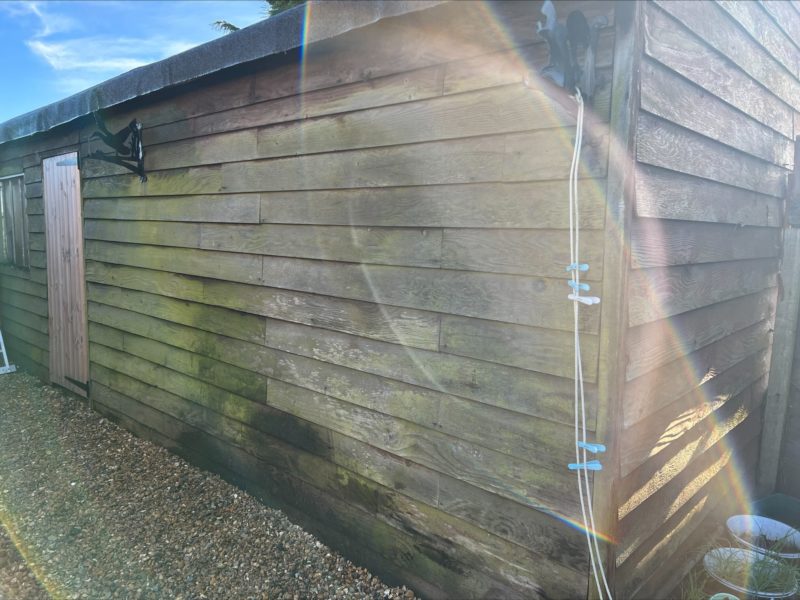
And then here’s a look at one coat after – this is with the sprayer – looks a bit patchy up top so I’ll get you another picture when that dries properly in a week or so:
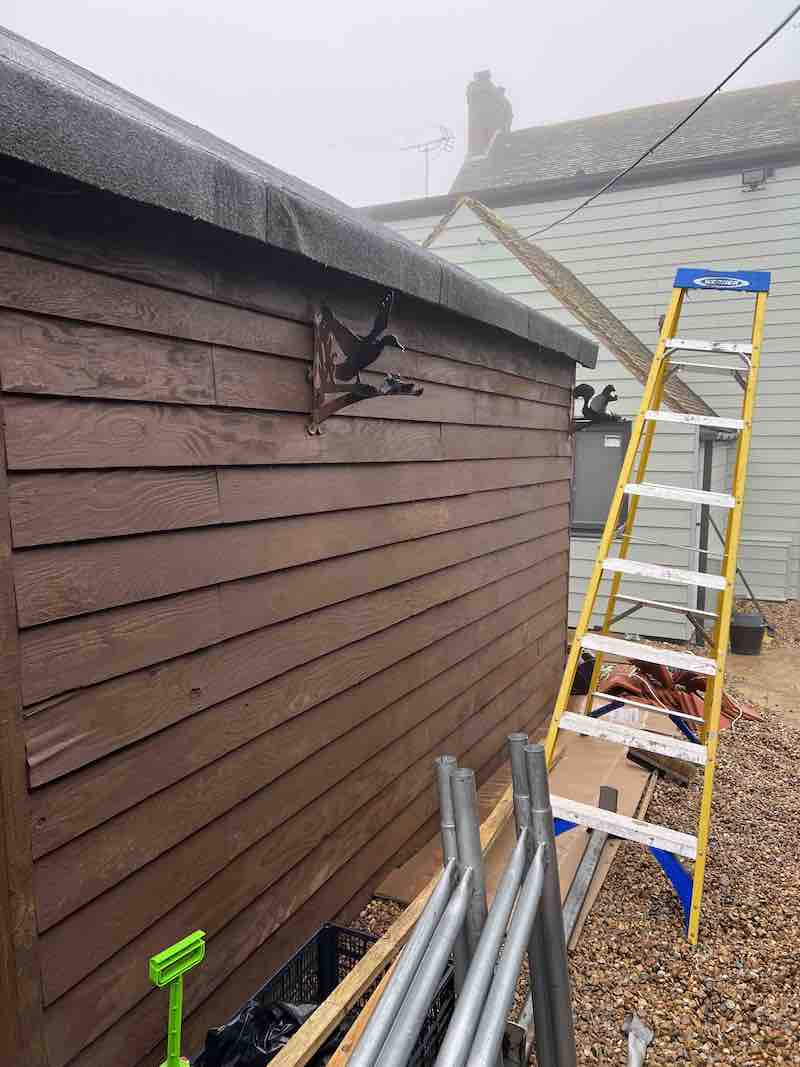
PRO TIP: BEFORE buying the best shed paint be sure that you fully understand the difference between a rough and smooth shed paint. Some paints and stains are no good at all on smooth surfaces that I found from extensive testing!!! There are some shed paints MUCH better on smooth wood.
Best shed paint and stains – editor picks for fences too:
Best shed paint that is waterproof [tested]: Cuprinol Duckbacks 5 Year Waterproof For Sheds and is also the best fence paint – so no wasting left overs!
Best direct alternative to Cuprinol [tested]: Ronseal One Coat life
Best traditional natural look [tested]: Creocote – amazing alternative to the now banned Creosote!
Best shed paint for smooth wood [tested]: Cuprinol or Ronseal Fence Life Plus Paint
Best for an electric paint sprayer [tested]: Ronseal Fence Life Plus Paint or if prepared to mix yourself Cuprinol slightly better value
Best paint for tongue and groove shed [tested]: For natural look Creocote if rough surface – for a painted look on rough and smooth surfaces Ronseal Fence Life Plus Paint or Cuprinol
Best shed stain [tested]: Creocote or Creoseal
Best oil based shed paint [tested]: Creocote or Creoseal
Commercial grade protection [tested]: Creocote is definitely the professional pick – then Cuprinol and Ronseal
To save a bit of time, though I recommend reading this review entirely as buying is easy. I can save you hours in application time literally! If you’re looking for a natural finish, Creocote is worth a look, if you want the best fence paint with colour it’s got to be Cuprinol – this can be mixed with water and used in a garden or electric paint sprayer. If you don’t want the hassle of mixing yourself then it’s a no brainer – you go to the Ronseal One Coat. For smooth timber, both the Cuprinol and Ronseal Fence Life Plus Paint are spot on, Creocote totally failed for smooth timber so don’t make my mistake 🙂
If you like to hear other people’s misery then read on (if not skip to the what you need to know about shed paint / buyer guide section with this link or shed paint tests) 😀 I basically converted my shed into an office with insulation. Before I insulated the shed though, I used a quality roof woodworm treatment (last chance as I was covering up the trusses). I had to clean/repair the shed roof (I then sealed the shed roof with paint/sealant), cleaned up the exterior – if your shed looks like mine below then before painting/staining you’ll need a decent algae remover or moss killer. I blasted mine down with a petrol pressure washer to great effect and saved that cost:
It didn’t stop there though! I installed windows in my shed, gutter guards, and then a complete electrical system with it’s own RCD. The most important part of all that for you though was what paint I used on my shed – I was going to go with an exterior wood preserver that has a paint colour pigment like Ronseals or Cuprinol but instead opted for the creosote substitute which can be applied with a standard garden sprayer (I personally used this for the 18 month shed paint test), but you can also use an electric fence sprayer:
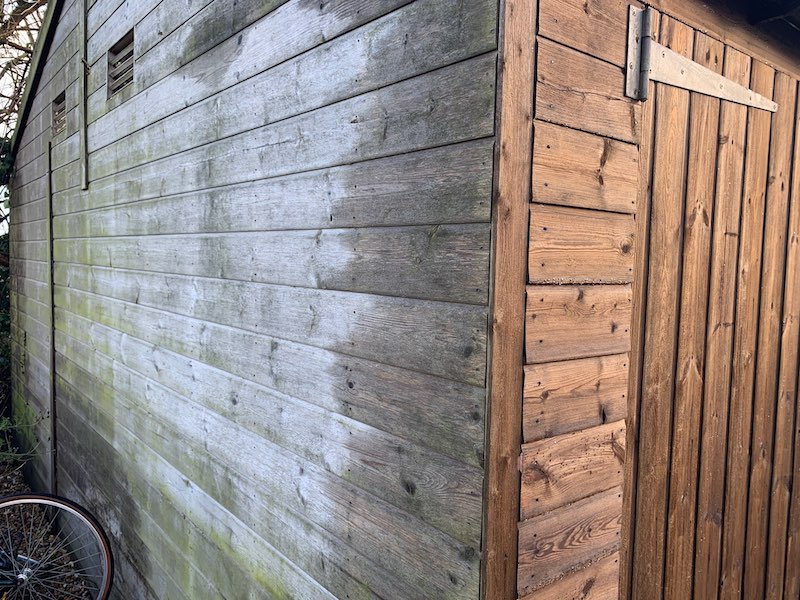
Now interestingly, at the same time last year I used Creocote on the shed, I used Cuprinol Duckbacks on the fence and gates. So now we can test the results 18 months later of each, and see which held up best 🙂
Last time I wrote this article I focussed on shed stains, but after a number of emails from you guys I realised my mistake – some looking for an actual shed paint – basically a preservative for sheds but with a paint pigment – just like my top fence paint pick the Cuprinol Duckbacks:
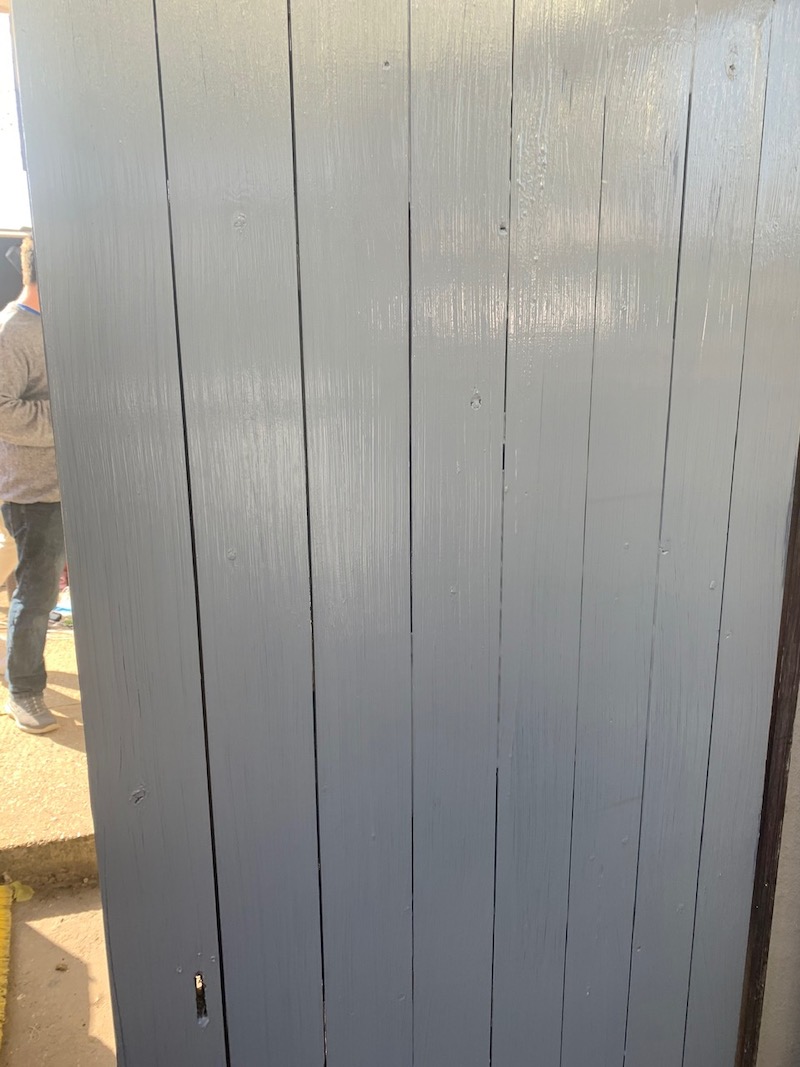
And to be fair it’s so easy to get confused with the myriad of products available these days – they call them shed stain, shed paint, shed treatment etc. Do they really mean a wood preservative for sheds with a paint pigment or an actual timber colour enhancer (stain/varnish/teak oil)? Let’s take a look at the difference:
The 18 month shed paint test: Creocote vs Cuprinol Duckbacks 5 Year Waterproof For Sheds
It’s always handy to benefit from experience. In this case I’ve got the Creocote vs the Cuprinol Duckbacks For Sheds. Now I have to say, I love the Creocote far more from an aesthetics perspective but you’ll have to take that with a pinch of salt as I like the natural wood look. I was a bit concerned though I’ll have to admit, when I first applied this I did have a bit of a wobble as looked nothing like the lovely deep shiny look on the container:
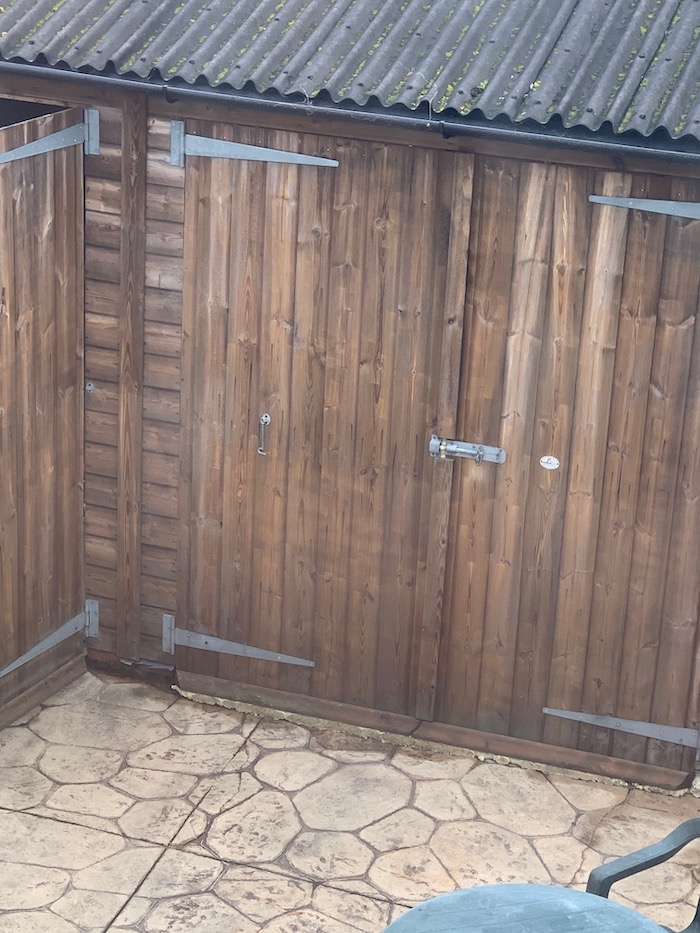
However, don’t panic, once the colours calmed down a bit (dried thoroughly) and the shine came through (took about a week or two from memory) then things started to look just as I had hoped:
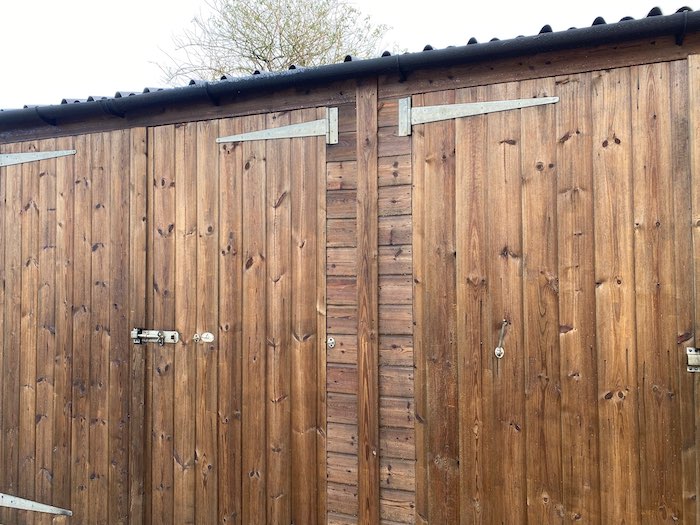
Honestly I was over the moon with that finish – teak oil wouldn’t come out looking that vibrant and costs an arm and a leg when compared – I used the dark brown Creocote – lighter might suit you more but I think the look above on a nice redwood (Pine as you’ll know it) is pretty spot on. However, moving on to now, 18 months later, it has started to fade a bit in my opinion (not bad considering the poor shed hadn’t been treated for ten years before I got my hands on it) but why don’t you be the judge – sorry about the shadow, I’ll try to update this picture at some point soon:
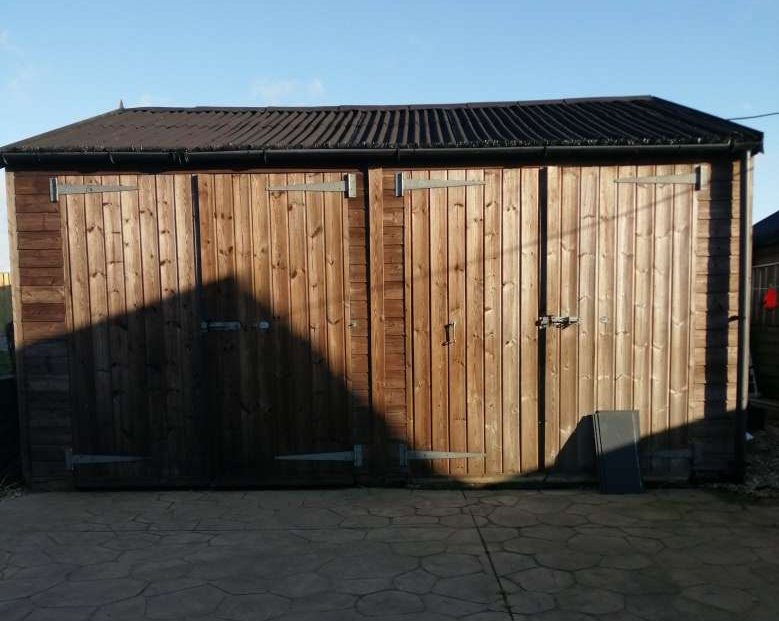
I am probably picking wings of flies a bit with the fading thing – that’s South facing too, so takes the full Sun blast. Overall considering the powers that be stripped us of good old Creosote as it’s too toxic, the environmentally friendly Creocote replacement is doing a pretty good job – it is DEFINITELY not as good though – the old Creosote which is basically wood or coal tar was nasty stuff, in a very good way for shed protection 🙂 or fences, and any external joinery for that matter.
So moving onto the Cuprinol Duckbacks. My sister painted this at the same time as the shed and in my mind the brush was a total fail – if you have awkward bits, or even just square trellis a big brush is total overkill but what was impressive – bare pine that’s light completely covers in one coat:
I’m really not a fan of those big brushes – she tried to lay it on thicker before the video and it dripped, a sensible 3 inch normal paint brush is fine. However with all the negativity, it works lovely on smooth wood to give a crisp finish for one coat and bonds lovely to smooth timber:
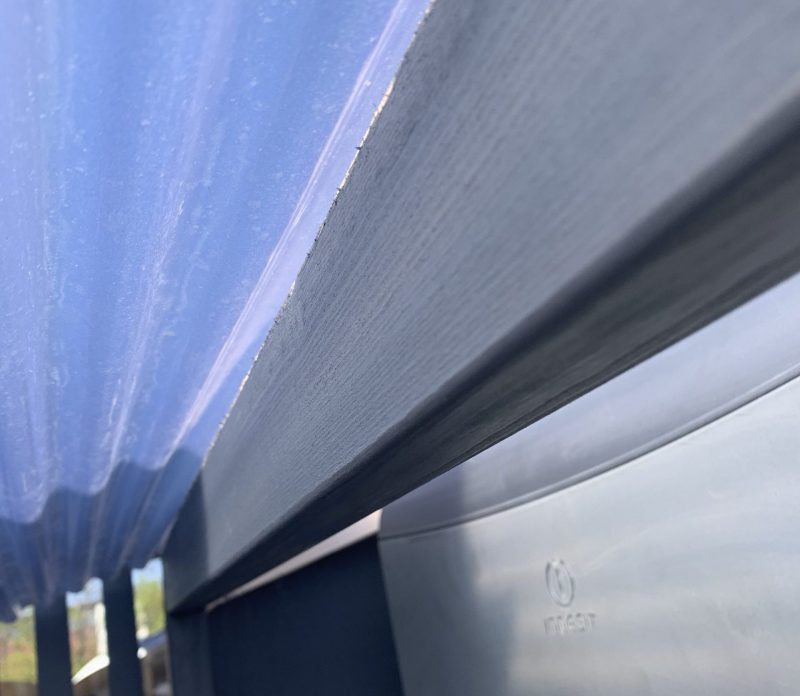
I have to say for 18 months on this is still in super nick but looking a little patchy maybe:
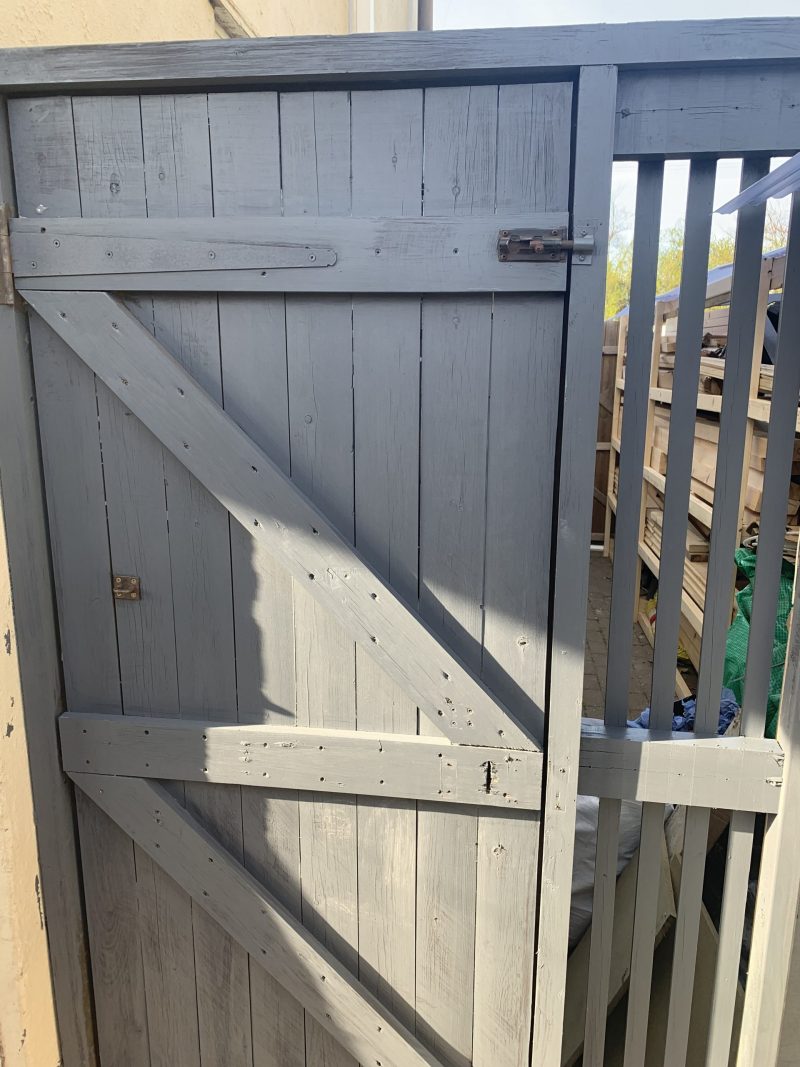
If I’m being very critical you can maybe start to see a bit of breakdown / cracking on the top right? Otherwise it looks nearly as good as the day it was painted. Not surprising for Cuprinol though, it’s the brand the trade turn to for wood protection, no question on that.
Second shed and fence paint test:
Test number two is on some gates I installed – they act as a fence but I wanted access behind the shed (empty field outback so idea access for the fence and shed rear) – this is really smooth timber and it did drip when I got too heavy with the application using Creocote – if I did this again I’d coat up much lighter and multiple times (no rush is there I guess?) but more likely use a paint based on this testing:
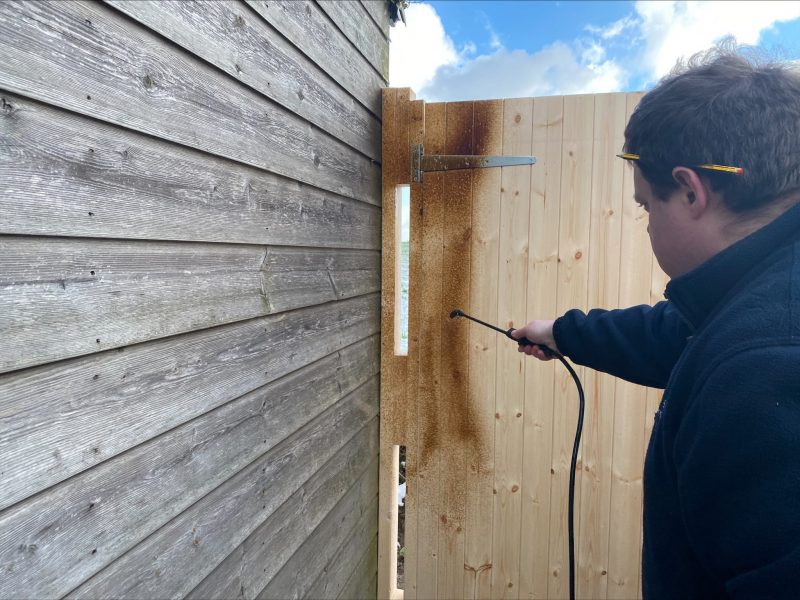
Looks like it’s going on lovely but when compared to the roughish surface of the shed it’s much more smooth and the creocote simply didn’t absorb as deeply and began to drip:
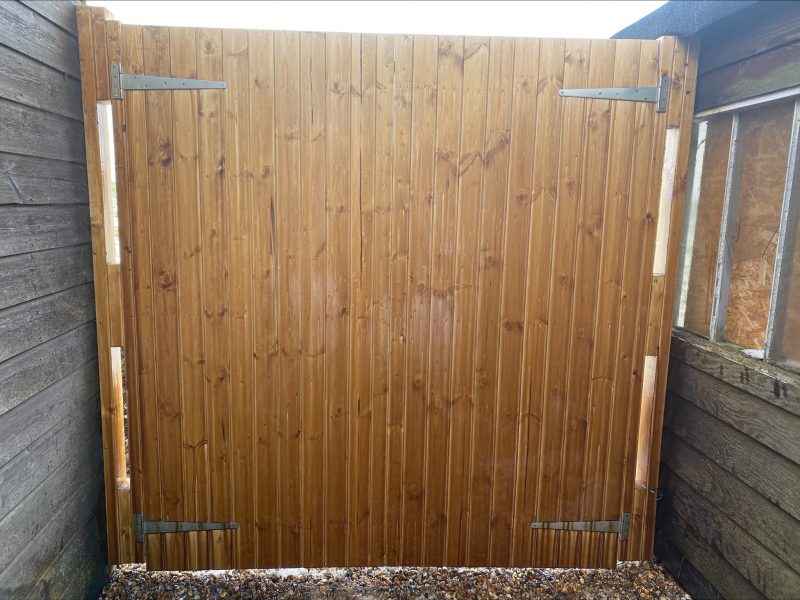
As you can see no big deal but a) a waste of Creocote, and b) this stuff really stains so if that was your patio then you would be furiously emailing me. Instead you can send me a thank you email with the heads up – I made the mistake so you don’t 🙂
However, here’s a look 18 months on at how that’s held up – I will need to coat this again and I would say from testing a paint pigment probably better (like Ronseals or Cuprinol) for smooth timber, you can clearly see it’s lightened up too much and more matt than the rough timber finish – in fact you might be scratching your head wondering where the colour has gone 😀 In short summary, no creocote for smooth timber, don’t waste your time.
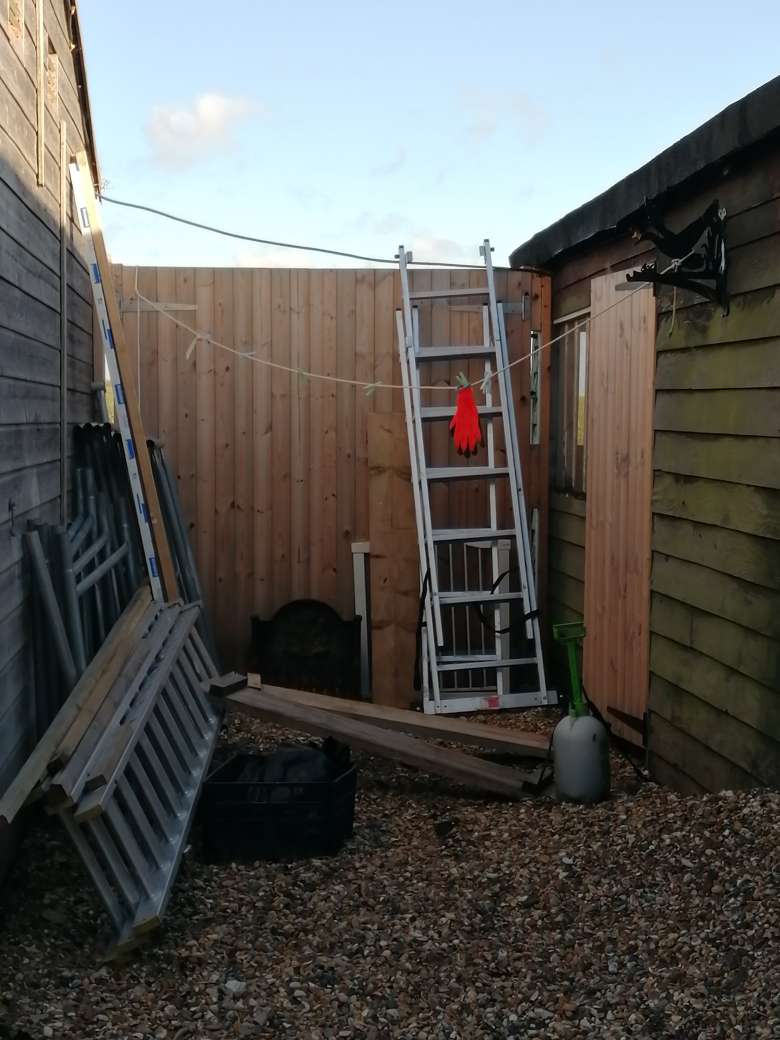
So what I’ll do next and in the reviews below is do a split test and spray one side with Cuprinol, and one with Ronseal so you can see how it’s holding up!
So with those tests out the way I did learn some bits that’ll help you in picking the best shed paint for you:
What you need to know about shed paint
Surprisingly (or not depending on how much you know already) there’s a fair bit to shed paint. It varies from stains, to actual paint like you roll on a wall, all the way through to treatments. Most people are looking for one of the shed paints in my test (judging by the emails I’ve received). But when I tested them I learn’t a great deal that you can benefit from:
Some shed paints are better on smooth wood
From the extensive testing above, the thinner paints and stains struggle on new smooth timber – they just don’t hold. The thicker, more paint like consistency of the Ronseal and Cuprinol is much better for these in terms of application. I have to say though, this is subjective. If you go steady with Creocote and are willing to layer up the coats you can get a cracking result without wastage. In a rush though, you’ll pick a paint consistency. As you can see from the above picture, Cuprinol will coat in one. Here’s that picture again:

By contrast the thinner stains work miles better on fury timber (rough timber). My shed just ate and ate Creocote as you can see from the tests above. There was very little wastage and you could easily apply it with an electric sprayer – I would warn though, a fine mist won’t do much for your lungs. I had a glass of wine on the side whilst doing mine and I underestimated how potent it was even through a mask – put me right off my wine (and that takes some doing 😀 ). So yeah, safety first and keep this stuff out of your lungs.
How to apply shed paint
There’s no right or wrong answer here but the observations from my tests as well as decades of experience tell me thinner paints and stains are better with a broad brush or at most a garden sprayer. I have to say when I use one of those brushes my sister used in a test of Cuprinol, I do lose a lot of treatment on the deck so be warned, not the cleanest method.
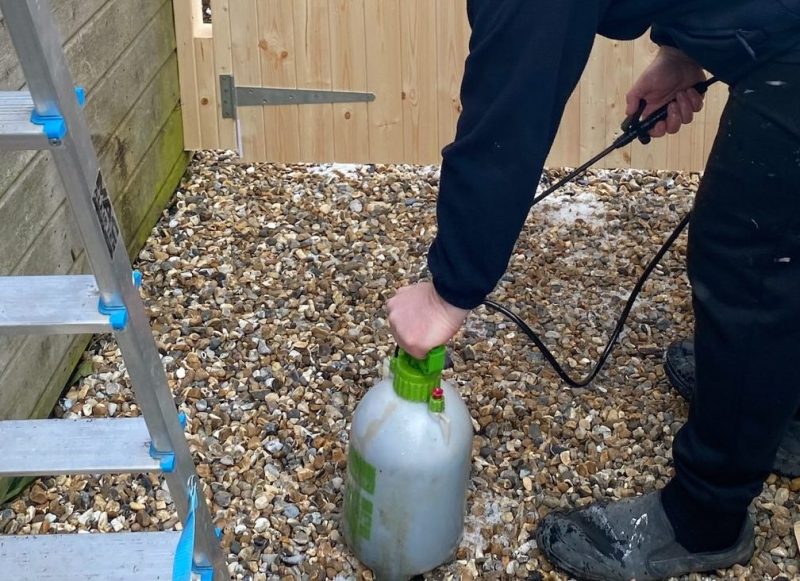
The thicker paints will go through an electric fence sprayer – you can also water them down a bit but the Wagner can normally handle it sensibly well but the Fence Life Plus will go through your sprayer without watering down – bare that in mind and may be the convenience makes the extra money worth it. As I mention in the Cuprinol review, I get a clog from not mixing up properly. You’ll want gloves, some sensible jeans, and a shirt/jumper that covers you up. A mask is useful with the thinner more toxic stains like Creocote. I would still advise masks on the weaker shed paints mainly to follow manufacturer directive.
Coverage
Some of the better shed paints are literally good to go in one, at most two full coats. By contrast trying to save a few quid will leave you pulling your hair out. Four or five coats is realistic – I won’t name names but needless to say they haven’t made it to my review! I made that mistake so you don’t have to. How often we get caught in a ‘value trap’ scares me to be honest (well I’m a sucker for a deal that’s for sure), but you get what you pay for with shed paint.
You can normally get about 25-30m2 out of a pot of the Cuprinol and the One coat Ronseal 5 litre tubs (6 fence panels or a small-ish shed). Forget the manufacturer guidelines, I don’t even know what they are. That is what I achieved from actual testing so far more relevant than what the back of the tin says!
1. Cuprinol Ducksback 5 Year Waterproof for Sheds and Fences
Cuprinol Ducksback claims to be pretty much everything you want from the best shed paint, and to be transparent I am a total Cuprinol nut but Ronseals shed paint gives them a real run for their money in this split test and is it’s direct and best competitor, it’s hard to pick them apart when compared directly and pretty much came down to price. I am always banging on about their Cuprinol 5 star wood preserver I have used for decades (sadly formula changed a bit now but still super effective). The coverage on this is pretty much superb. Watch how I cover an oil patch from the previous owner who decided to leave an old rag laden with engine oil lent against it for years 😀
Here’s a look at how everything went for me using a Wagner fence sprayer:
Now before I bang on any further, I have used your traditional wood colours here in testing. But I just want to point out they do have some cool colours – my sister used the Silvery grey as tested above and also the link to eBay has the Blue Ducksback she used on her front fence here – this was the day we painted it:
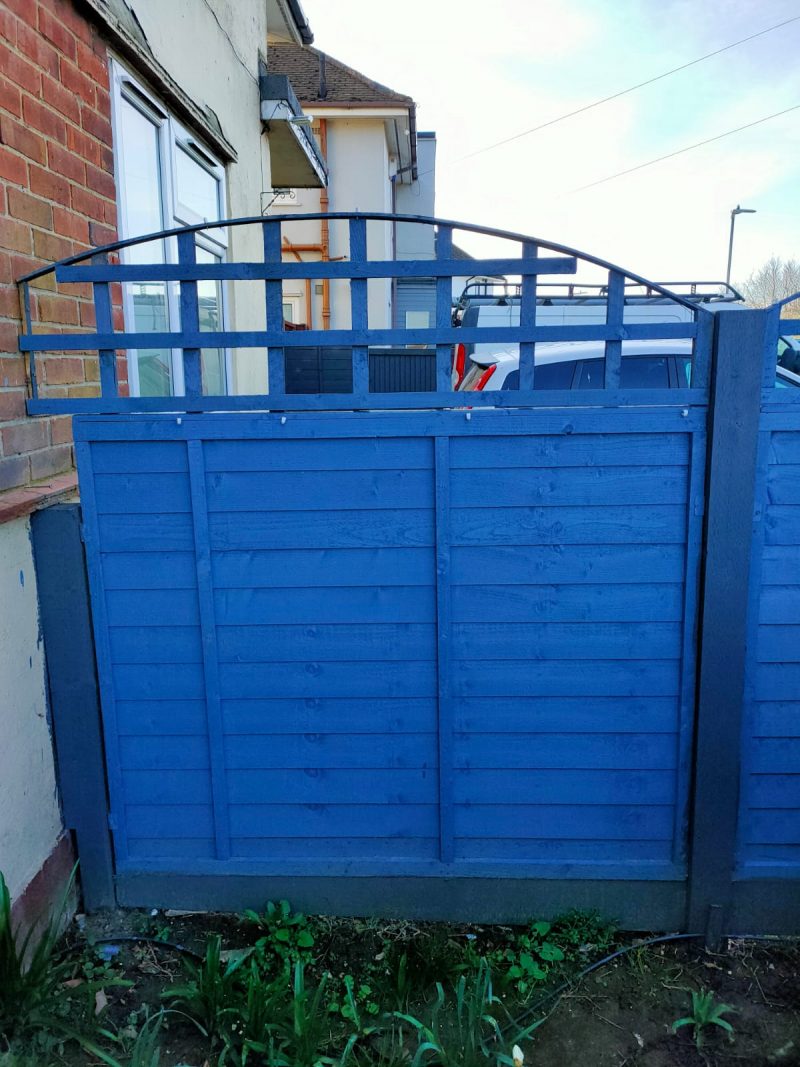
Now here’s a look a couple of days later, it dulled a bit after drying so this is a true representation of the colour you’re actually getting. If you checkout the after a couple of year shot further down you’ll notice the lighting has probably made this a little more dull than it is to be fair.
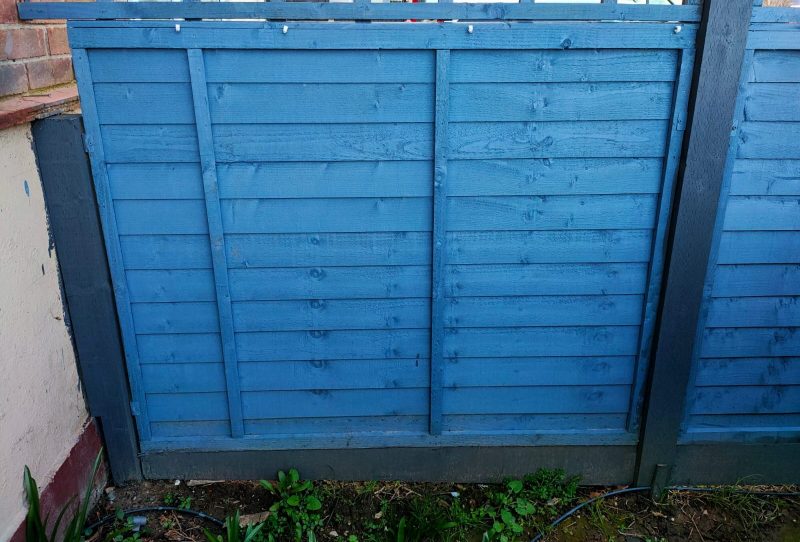
Now here’s a look at this a couple of years on and to me it is in nearly as good condition as the day it dried. Here’s a look at that:
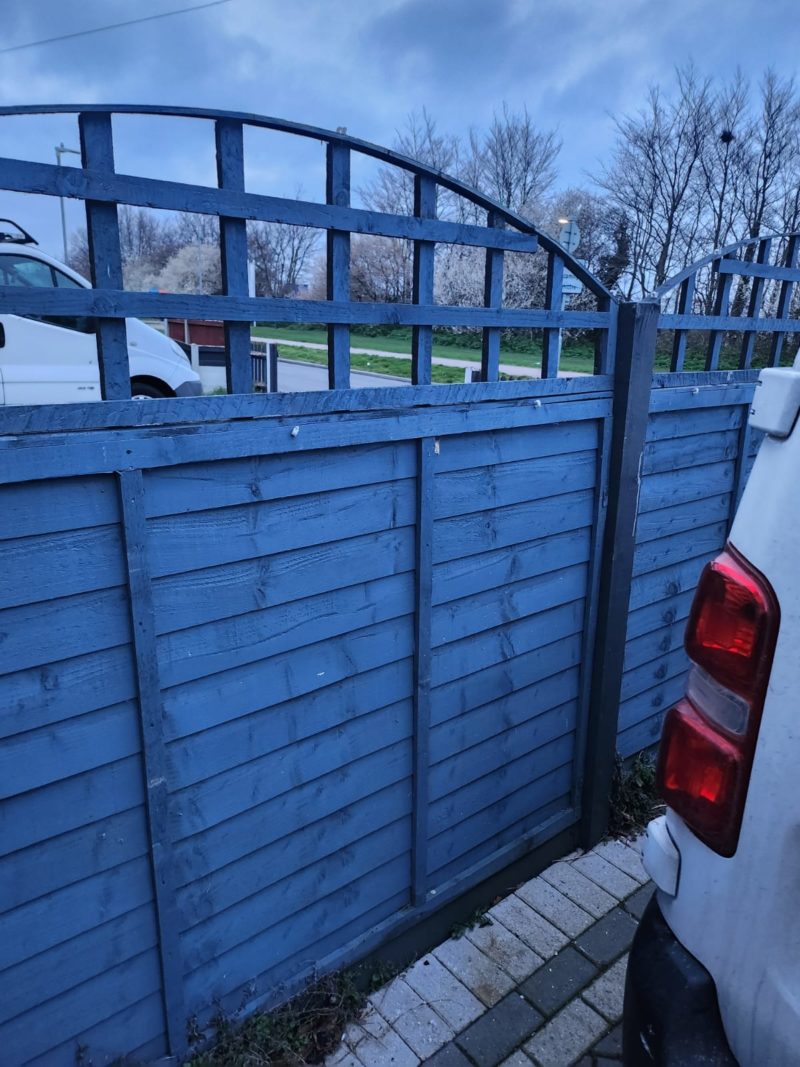
I’ll update this yet again next year but there’s no way I’ll be painting this at any point soon. So as you can see, this really lives up to the guarantee. If anything it might even look a little bit better than the day it was painted. Very nice paint!
As you can see it holds up pretty well so if you’ve any leftover from the shed then the fence won’t complain…onto the tests:
Test Duprinol Ducksback for non drip and showerproof:
I wasn’t going to just read off their product description and allow them to make claims like: “Showerproof in 1 hour” or “Non drip” without giving it a thorough testing for you guys to see first.
Well that was interesting with regards to the shower proof – now bear in mind I gave this every chance by recreating the exact environment they’ve asked for (thin ish coat, warm ish temps) – it actually did what it said IF I didn’t try to apply it too thick. If you try to ‘cheat this’ paint by laying it on like tar it cannot set in an hour. But yes, layered up (2/3 layers) it’ll set in an hour and yes it’ll be waterproof. I have to say this is a massive advantage over my personal favourite the Creocote which failed that miserably despite being oil based!
So let’s look at the non drip. As you can see from the video it is pretty thick and gloopy, a bit like tar – if you’re not trying to lay this on like plaster then yeah, I’ll give them that, this really is non drip to be fair – IF applied with a brush (electric sprayer + garden sprayer need thinning). Here’s a look at the block brush aggressively pushed into the pot:
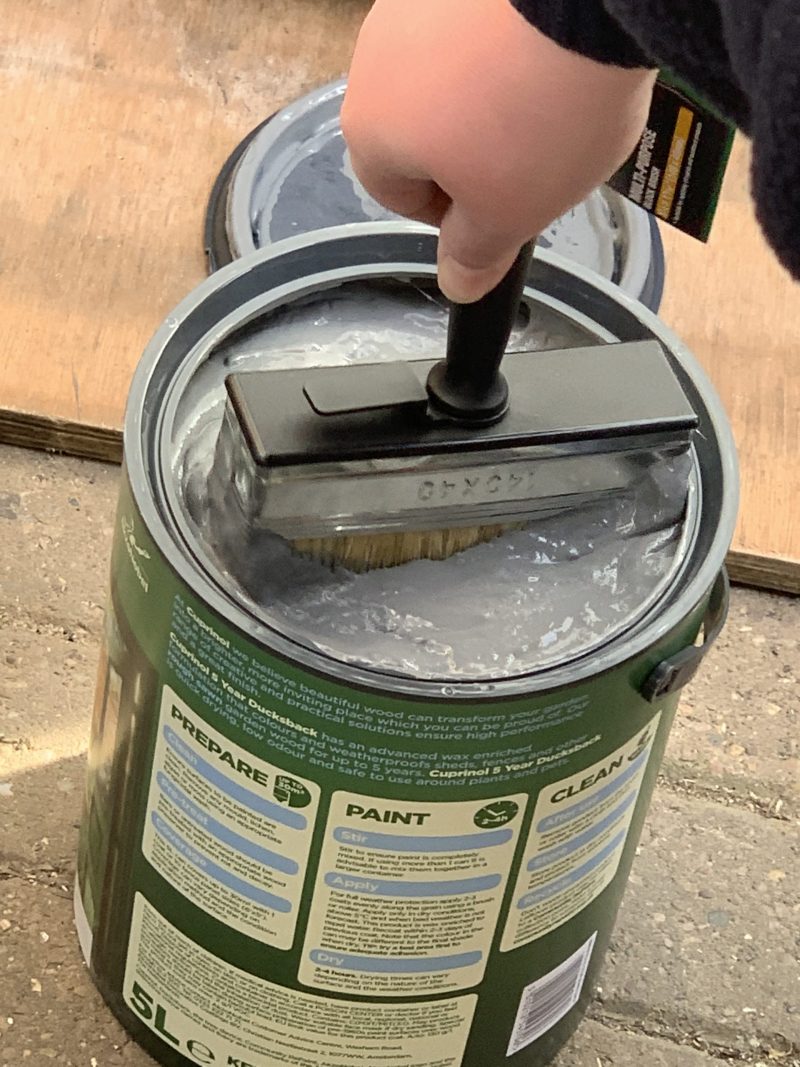
Notice the block brush fits pretty much perfect into a 5L pot. I’d call it tin, but it’s not, it’s plastic…Now look at how much is on the brush – the stuff holds like Tar and really to be fair, really is definitely what they claim – non drip – any thicker I’d have to start calling it filler or plaster 😀 Here’s a look at that:
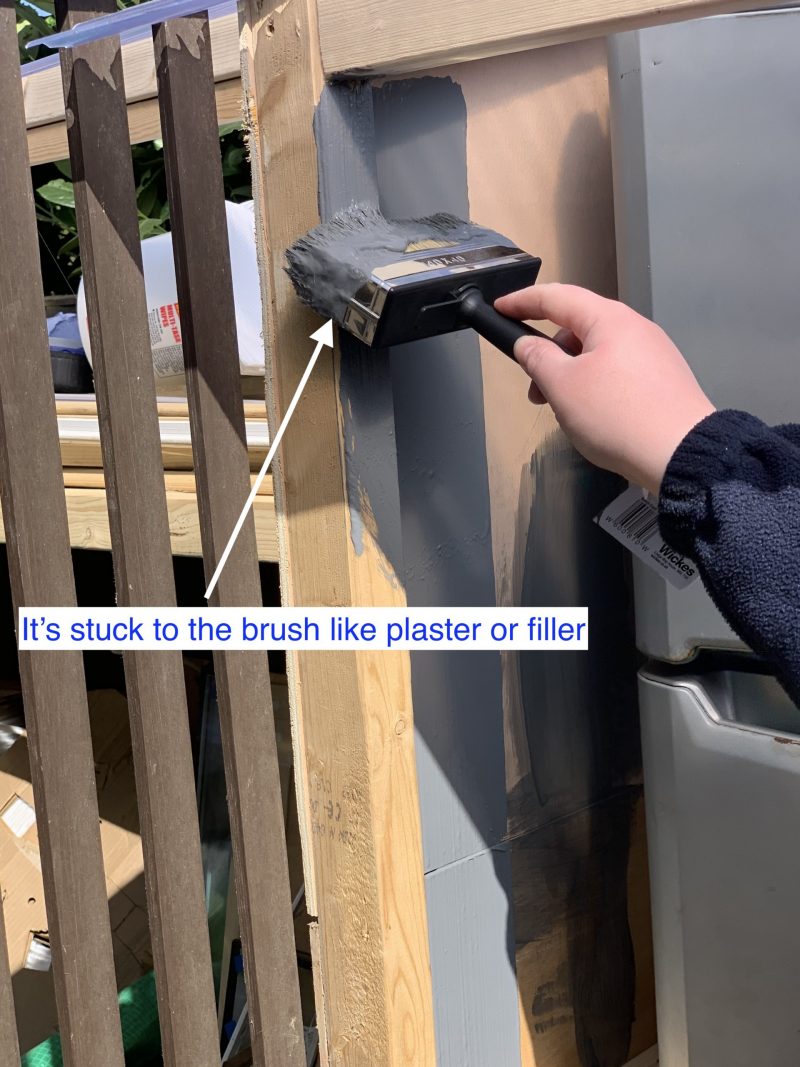
The video above demonstrates it better in my opinion though, I kept it as short as I could.
Does it apply with a garden sprayer? Well, actually that was the biggest surprise for me. I thought it it wouldn’t go but watered down to a 2 to 1 mix (two Cuprinol, 1 water) I got this through the garden sprayer. Interestingly, it’ll go through an electric fence sprayer at that mix too. If I was doing large areas I would definitely look at a cheap fence sprayer like the Wagner in this test, assuming I had no worry of overspray mist upsetting or ruining anything.
And what I learned from that test was you’ll need two or three coats – yes the finish looks crisp but did I save any time when hand painting is one two two coats max? 🤔 Add to it the problem of overspray and protecting your lungs, I’m not sold on that but it is quicker for sure. Be your own judge though – here’s before one coat:

Here’s after one coat – considering it’s watered down very impressive:

And this is how it looks the next morning once properly dry:

Now, I ned to zoom in to show you the whole story. Here’s a close up of what’s going on with one coat:
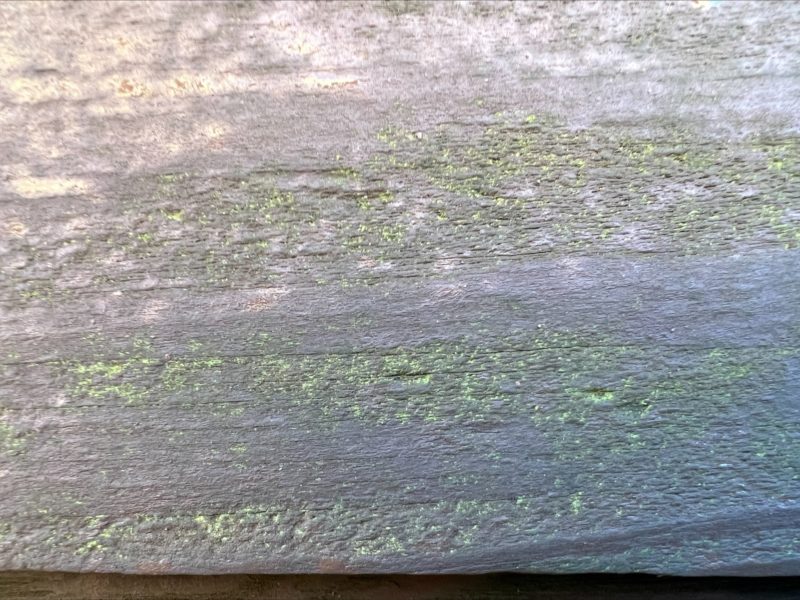
And here’s a second coat close up – I decided I am happy enough with two coats but since you’ve got the sprayer out and paint left over then I see no reason not to blast a third if you don’t want to do this again for a long long time:
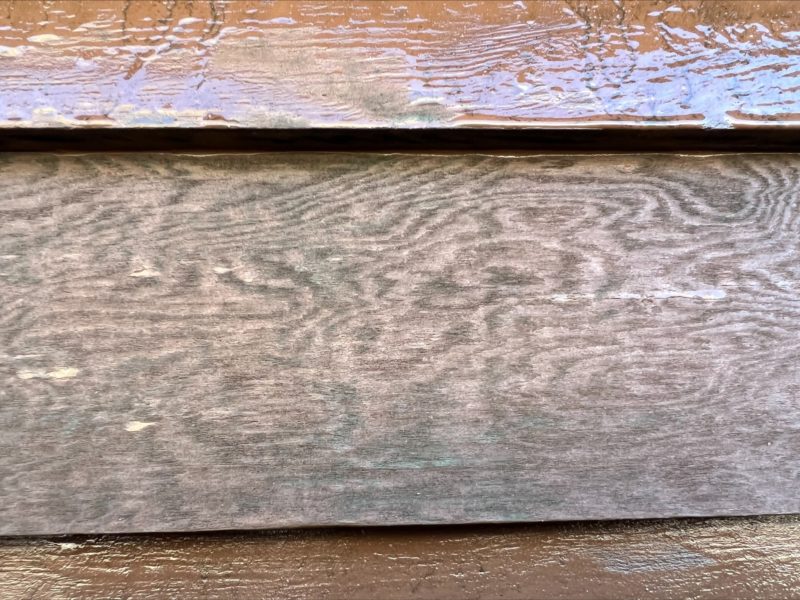
Now to the bad points of using a garden sprayer and electric shed/fence sprayer.
One thing I noticed was the clogs – first up I didn’t mix thoroughly and sure enough I got smashed when using some of the cheaper electric sprayers – my Wagner a different story though. The expletives were in full flow but my own fault. Once I realised what was going on and spent some time mixing properly I didn’t have any more issues. I have to say, my fault, and not the sprayer (didn’t clean it out, let it dry inside the spray nozzle too)….and actually I picked the Wagner as best fence sprayer. It definitely deserves that title. It’s a lovely bit of kit and works just great on sheds and fences (notice almost all best shed paint is perfect for fences too). I make sure I keep that nozzle clean and it’s good to go everytime.
So with everything dried I have to say Cuprinol is a superb product. Add to the fact I know how well this holds up from the 18 month test. It’s hard for me to pick Ronseals over this but I do see decent anecdotal evidence online from Ronseals too and my own testing showed me it’s a good product too…let’s look at that if you’re not sold yet 🙂
2. Ronseal RSLFLPPDO5L 5 Litre Fence Life Plus Paint
Now before I get into Ronseal Fence Life Plus Paint, if you have rough-ish timber then you can skip to the next review below – this is essentially more expensive than the one below and I don’t feel offers much more other than the fact you can use it with a garden sprayer and has a longer guarantee. However, if your timber is reasonably smooth then do not skip, as you’ll want this paint – it will seep into and dry much better. Here’s a look at how I got on with Ronseal life plus:
Before we get into this too much though I want to compare this directly to the Cuprinol. If you looked at me making a right mess loading this into the spray pot above, then you’ll have seen this is like jelly. It definitely doesn’t run easily. In terms of being waterproof after an hour the tests were not bad – maybe not quite as good as Cuprinol but very marginal. I won’t bore the hell out of you with this – it’s really quickened up this time:
So let’s look at this. Ronseal say you can use this in damp-ish weather and with damp wood. I have to say that’s reasonable enough – given this is water based it’ll dry out. However you won’t be doing this in the rain, it’ll just wash away – you’ve been warned on that 🙂 As you can see from my video I use dry wood but damp-ish conditions, I don’t mind the idea of getting caught out but with just 4 hour dry time I really don’t see planning as an issue and maybe a bit of an over sell here to me….
They claim to be shower proof in one hour – what do you reckon from my video test when compared to the Cuprinol? It isn’t bad… This is definitely reasonable and inline with Cuprinol when compared directly but this is much much thinner despite looking thick when I played with it. Now it is reasonably non drip but nothing like the Cuprinol. If you want a thicker consistency in the Ronseal range you’ll want to look at the next product review. You have to remember this is advertised (and fairly so) that it will spray with both a garden sprayer and an electric fence sprayer – so it has to be thinner – I don’t feel like this is a shortfall on the Ronseal if I am honest. I feel like this is a cracking product.
So let’s take a look at the coating thing. Ronseal reasonably say you need two coats. I’d agree with that – it’s much thinner than the Cuprinol off the bat but very jelly like, really wobbly as you can see from my video tests and the Ronseal one coat too is this consistency for that matter. Here’s before:
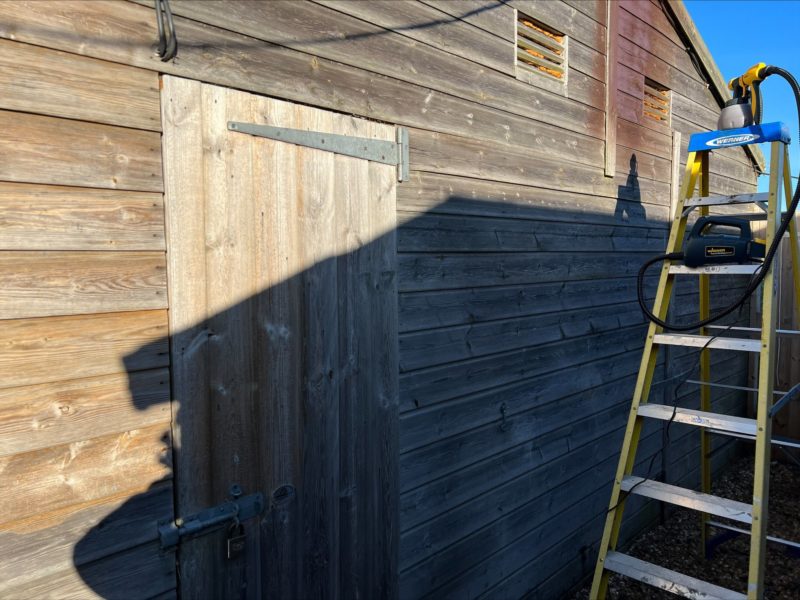
Let’s take a look after one coat on my shed:
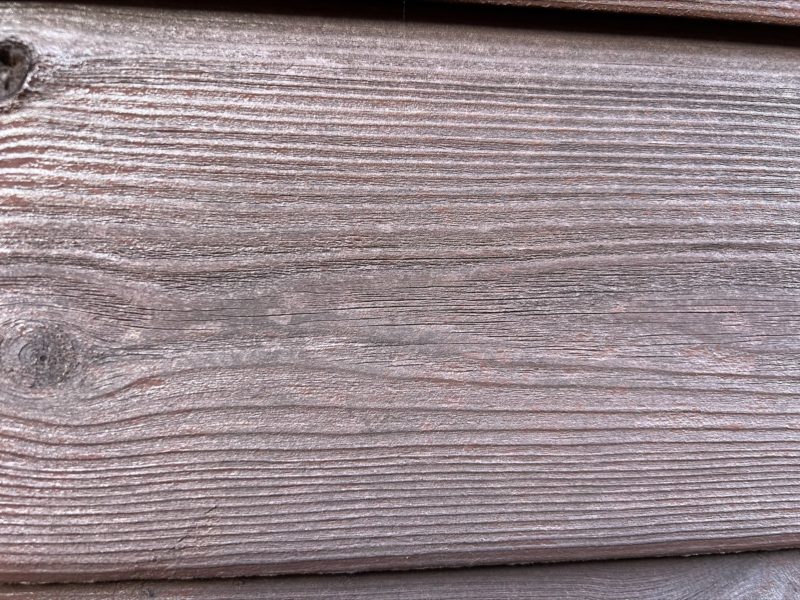
As you can see it’s covered pretty good but what the pictures might not pickup given how dark the paint is – this is a little bit patchy. I don’t think that’s a problem though, Ronseal are clear this needs a second coat. You wouldn’t dream of using this with rough timber in my opinion though when compared to the Ronseal One Coat – I just don’t see the value.
Now here’s a look at the second coat – nice and full looking:
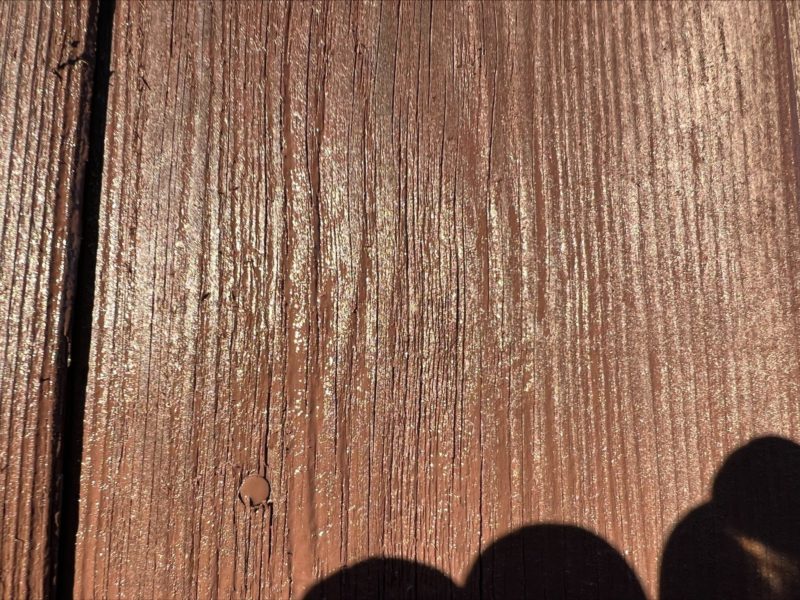
Here’s a zoomed out picture from one coat – I don’t think it helps too much as the knots look a bit patchy:
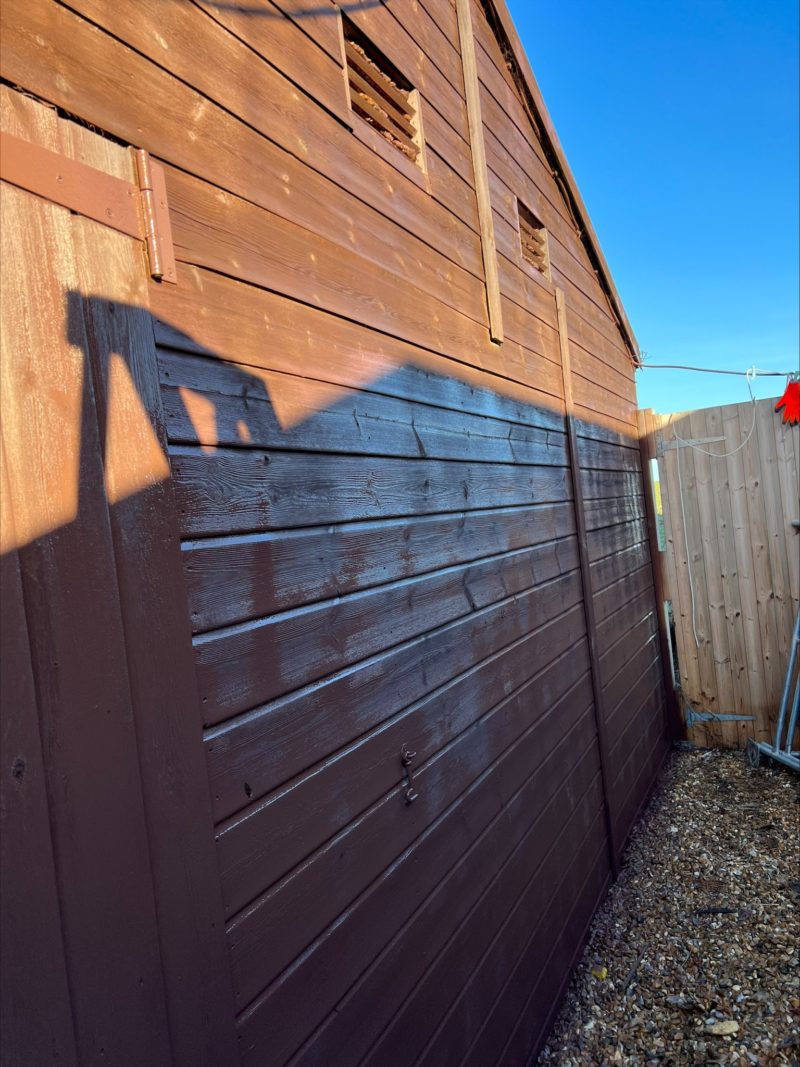
Here’s a better look the next morning after the paint has a chance to dry – so don’t worry if it looks a bit patchy before set:
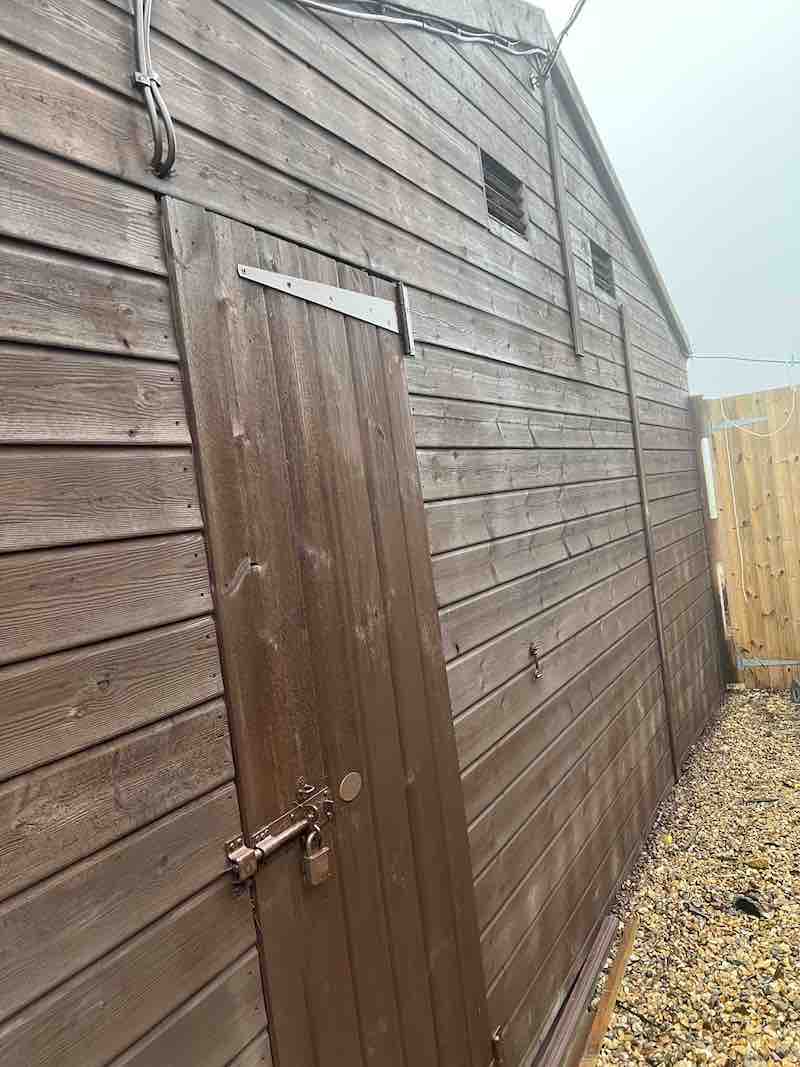
And here’s a look at the shine on it – definitely going to protect and repel water away rather than attract:
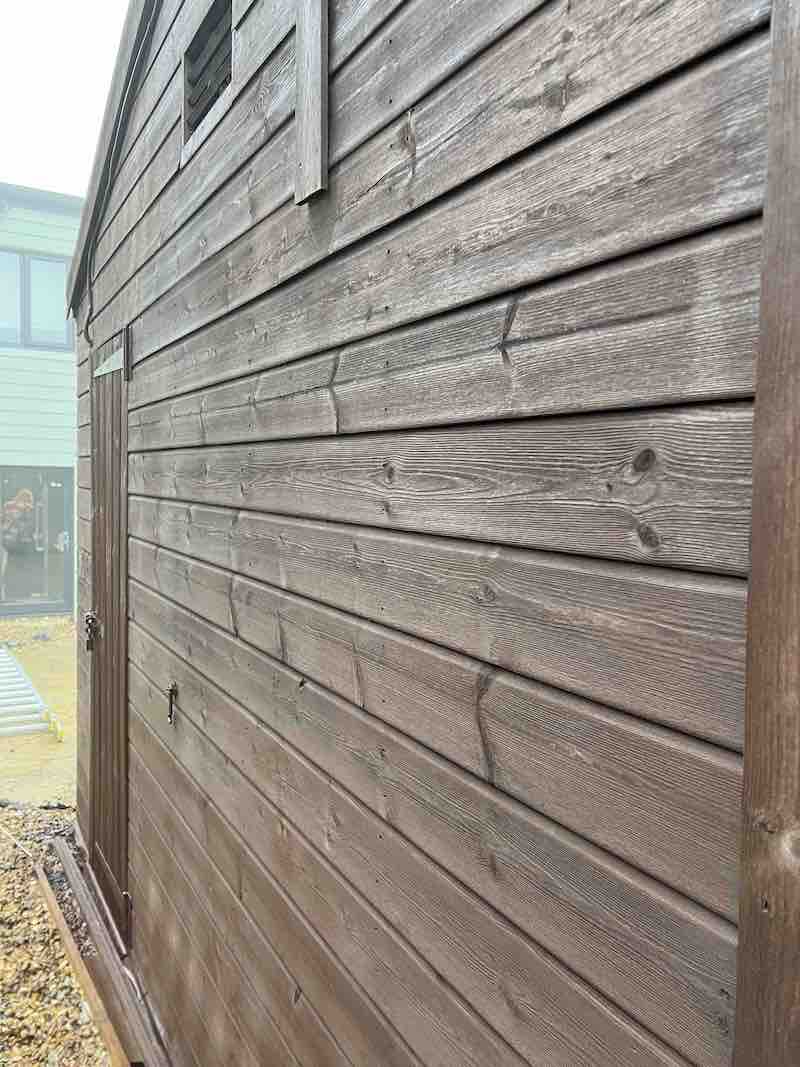
I reckon I’ll put another coat on it at some point in the warmer weather – I’ve still got some left!
You can’t really knock this product if I’n honest. Let’s assume you don’t want to mix up yourself but do want to take advantage of an electric sprayer – this is probably your best bet. The paint is a full and thick finish and the five year guarantee has proven the test of time with thousands of happy customers. It’s a difficult decision though between this and the cheaper Ronseal one coat if you have rough timber! I personally would go with the cheaper option in the next review below as I believe you get more product for your money!
3. Ronseal RSLFLDON4LAV One Coat Fence Life Dark Oak
Now I gave the Ronseal Fence Life Plus Paint above a bit of a rough time. That is mainly because I believe in this Ronseal One Coat product more in terms of value as shed paint goes. Let me tell you a little about what I know and why I’ve come to this conclusion.
Over the years I’ve bought loads of rubbish paint. It’s always has the same thing in common; too thin and not enough pigment. Invariably the thicker paints always cover better – this has never been proven wrong. So when I look at this cheaper product that is equally as thick, I have to question why getting the same paint pigment can cost less. I’d love to understand the difference but Ronseal’s themselves haven’t provided the answer (Ronseal are welcome to reach out to me and clarify this), so until then I would definitely recommend this paint over the Life Plus (assuming you are happy with one of the 6 colours vs 15 of the plus range), especially when this is itself water based like the Cuprinol and more expensive Ronseal! Note, Cuprinol are completely transparent about that too.
Now what do you reckon with the spray finish. I definitely think the sprayer does the business. Note I followed Ronseal’s instructions and overlapped the spray. You definitely have to do that or it is not one coat:
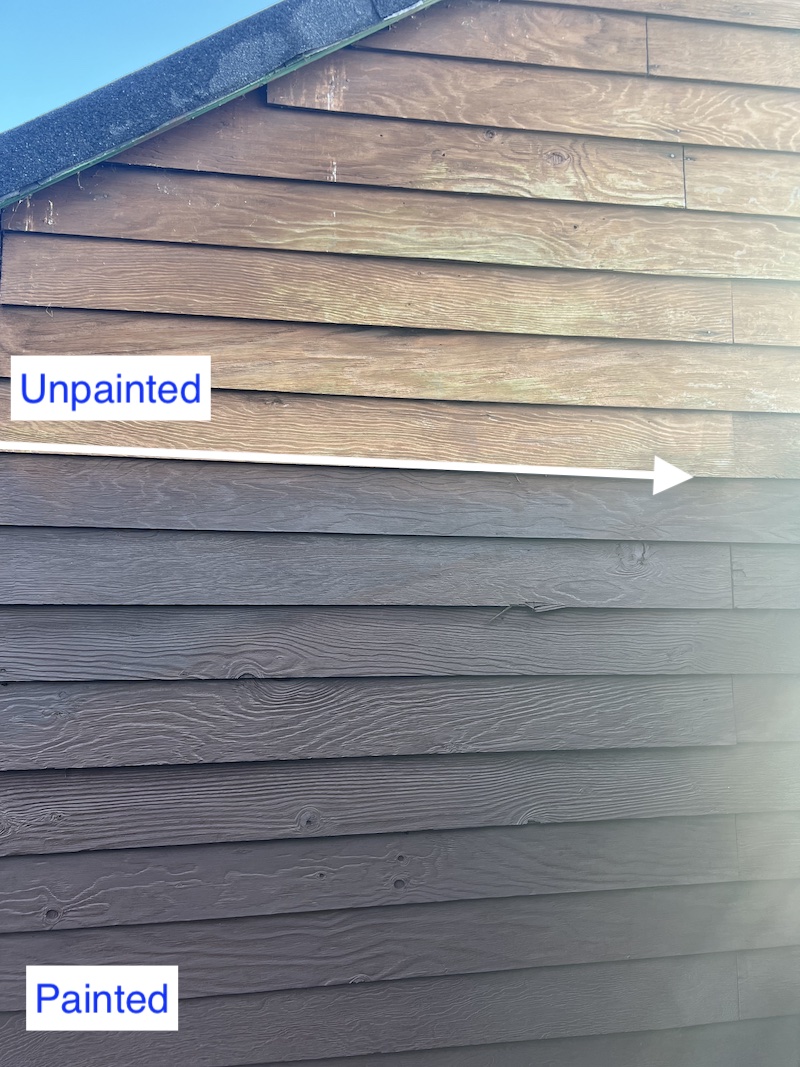
Now in terms of other claims that are probably less important than the above, they say this is guaranteed to keep its vibrant colour for a couple of years. If you look above at the Cuprinol blue colour test, you can see that fades too but is perfectly good and looks fine after the initial fade from drying and is protecting timber just right. I don’t see this as a problem and I think Ronseal are managing expectations reasonably (fair play on that) but worth a mention. I don’t see the need to coat this every two years and I think it’s a really decent product, and definitely the one I’d use behind Cuprinol. Here’s a look at the shed a year plus after I initially painted it:
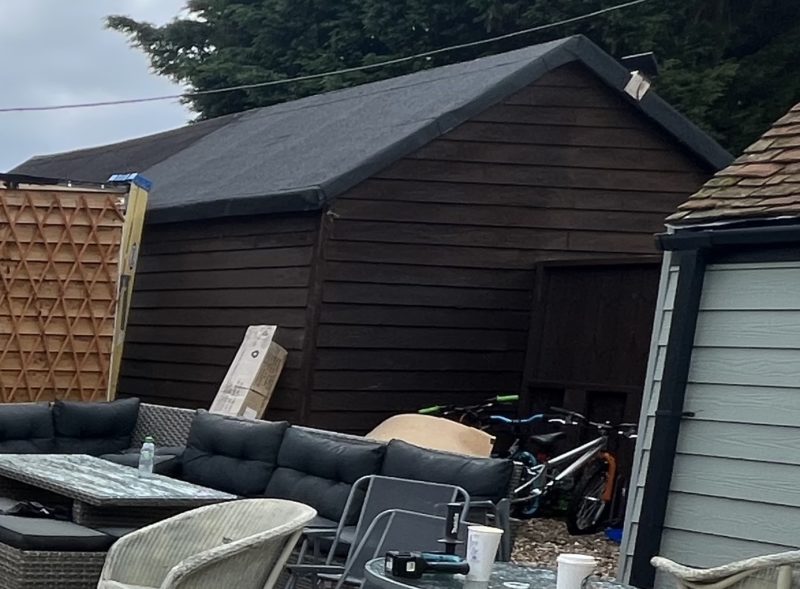
Like the other two top products above, this is also shower proof in an hour. The consistency is much thicker and inline with Cuprinol. If you look at the video below that I’ve kept as short as possible, there isn’t much to choose between this and the Cuprinol.
So in terms of application Ronseal say this is brush + sprayer. As you can see from my test above you can get much better value from a sprayer as it coats far more evenly. On that note, you want to be careful of drips (something I found when testing). They dry a different darker shade so you’ll probably re-coat in that case to get a deep look.
Interestingly they suggest you can paint this directly over the top of rough sawn wood that’s already been stained. I’d totally agree with that but as you can see from my pressure washer – I prefer to clean the shed up first, not so much concerned with the stain, but more an issue of any Algae or moss build up on the surface – you definitely at a minimum want to give this a good clean down or you’ll trap in that bio layer and definitely will reduce the effective time of this shed paint.
All in all, one of the best shed paints in the UK – no question of that and what I’d use if I didn’t fancy Cuprinol or the Life plus options.
4. Creocote - Creosote Substitute Dark Brown Timber Wood Shed and Fence Treatment
Update a couple of years later from original review. This is absolutely superb at deep timber protection. Even after a year this literally looks as vibrant as the day I first coated it. Being oil based it is in a different league when it comes to timber protection – here’s a look:
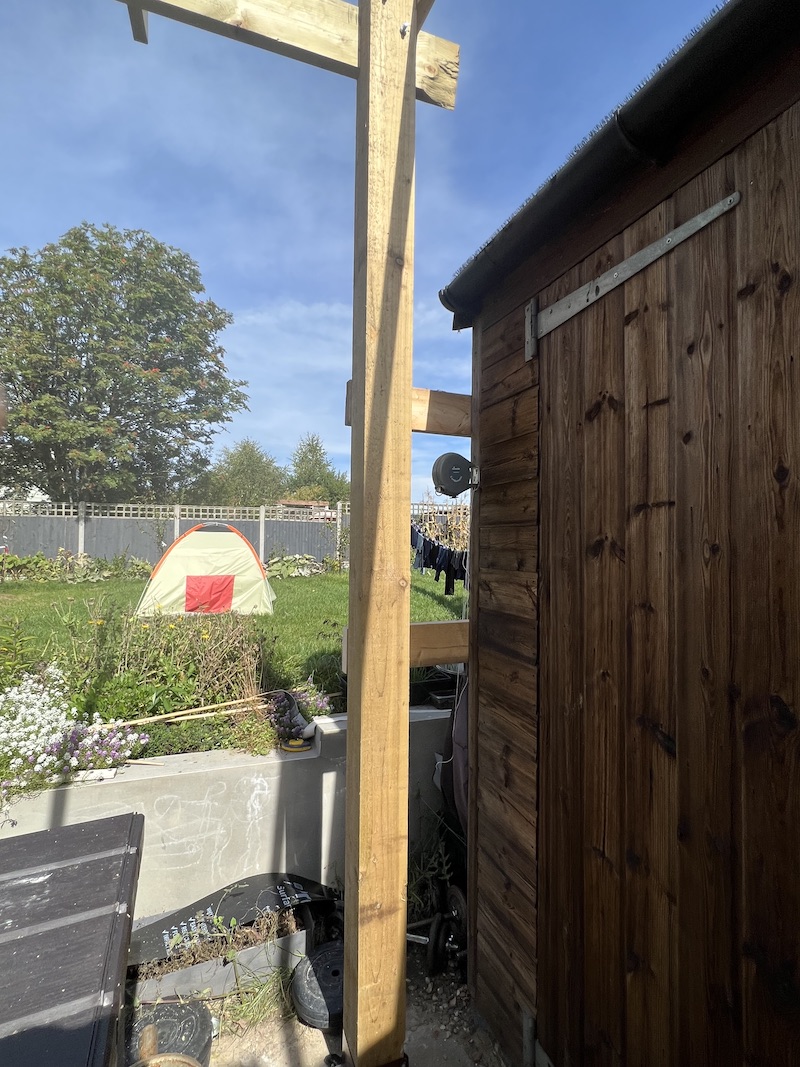
I will just say it again – you want a face mask when applying this without question – one that actually blocks the vapour well.
Old review:
Now for my personal absolute favourite. Creocote I buy this in a big 20L container and just leave it in the shed for as long as needed – no worries of evaporation or failing:
I know from personal experience it just keeps forever! If you’re here because you wanted oil based shed paint then you are in luck – it’s this or a very similar Creoseal to pick from in my mind! If you don’t know they (EU decision to ban creosote for home use in 2003) mainly because it’s proven to be carcinogenic. Don’t start panicking though – we’ve been using creosote for decades (or I have) and it’s still available in the UK in huge quantities commercially and it was an unbelievable product for sheds and exterior wood. Here’s a quick video of how I apply it – certainly rough and ready but quick and effective:
Now as you can see from my test pictures above I prefer the dark brown. There’s not much in it for the lighter colour, just a slightly lighter finish overall. Here’s a look at this side on so you can see the difference it’ll make before and after:

Now obviously this is in stark contrast to the initial colour you apply – whilst still wet it really looks dark and boring – don’t panic – it’ll settle as the picture above but just so you can see what it looks like (or watch the video above) when I finish applying it:
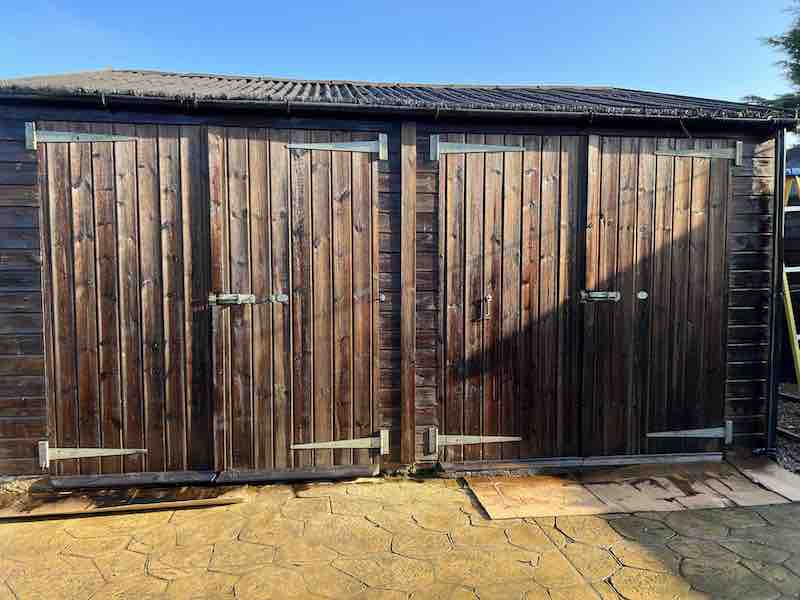
Now the interesting thing is, look at the water penetration and damp marks on the alternate angle I didn’t do yet to show you the difference! The creocote really does protect against water penetration and ultimately rotten wood.
So the thing about this is that rather than an outright shed paint, it is a shed stain and much thinner. This is extremely easy to spray onto a shed but you’ll need to set the mist to fine or it can run. Creocote applies best on really rough timber, just like that of my shed. It really does absorb right in and gives long long protection. I am already at 18 months South facing and it looks like new.
When applying there’s two things to be careful with. Firstly it’s really thin so runs. Secondly it’s nasty stuff and I would highly recommend wearing some sort of mask protection. I did mine on a hot day and the smell as serious. It genuinely put me off a glass of wine – if you knew me, you’d understand the gravity of that! 😀
I also made a massive mistake of letting this onto my printed concrete and I had just cleaned it without using a patio sealer yet. 😱 Needless to say if you had a porous sandstone you would literally have a heart attack – this stuff bites deep and stains (perfect for the shed obviously) but for anything else you really need protection.
5. Johnstone's woodworks shed & fence quick dry wood stain dark oak
Next in the list is the Johnstone’s woodworks shed & fence quick dry wood stain dark oak which is yet another good quality shed and fence wood stain that helps make it last longer without any issues. It is formulated with high-quality materials to ensure the best results and is also water repellent and helps resist the problem of fading that many often face altogether.
Like the Cuprinol this is water based and if you want to get it through a sprayer it’ll need knocking down and thinning – I’d test this carefully as the consistency pretty much depends on what sprayer you’ve got – most have a hand pump garden sprayer, or cheap fence sprayer, so that being said (and that’s what I tested with, a similar 2 to 1 mix of paint and water like the Cuprinol will work here too.
I know from experience it’ll handle weather and a frost – but would I pick it ahead of Cuprinol? Probably not. That is partial bias and partial knowing from years of testing. Johnstone are welcome to give me a bell and send down a pot – I’ll put it to the test over a couple of years for them no problem and gladly report back.
They claim it also has a specially enriched wax formulation which helps protect the wood in the sheds and fences from the harmful UV rays of the sun. In real terms, I’d agree this resists and repels water pretty well. Since it’s not oil based it needs something to resist water like the other brands!
- High-quality products for the best results
- Perfect for the exterior and the interior furniture too
- Protects the wood from UV rays from the sun
- Water repellent formulation and quick drying – about 3 hours for a coat – the manufacturer says 4
From a negative standpoint there’s not too much to dislike – it’ hard to pick in my opinion ahead of the Cuprinol given the price – most complaints you’ll see arise from the fact it’s delivered leaking or damaged – not much the manufacturer can do about that so the criticism seems harsh!
6. Creoseal Plus 25Kg Light Brown Creosote substitute Oil based wood preserver
I’ve emailed Creoseal for a test pot of this to test it side by side with the shed – from everything I remember (it’s been a long time) it is pretty much identical to Creocote. Given they are pretty much the same price (Bartolines version being a bit cheaper but 5Litres less) it really boils down to availability.
I haven’t used this for a while myself. If you take a look at my container I used literally 5 years ago, you’ll see it’s ancient and been tucked away in my shed for a long time.
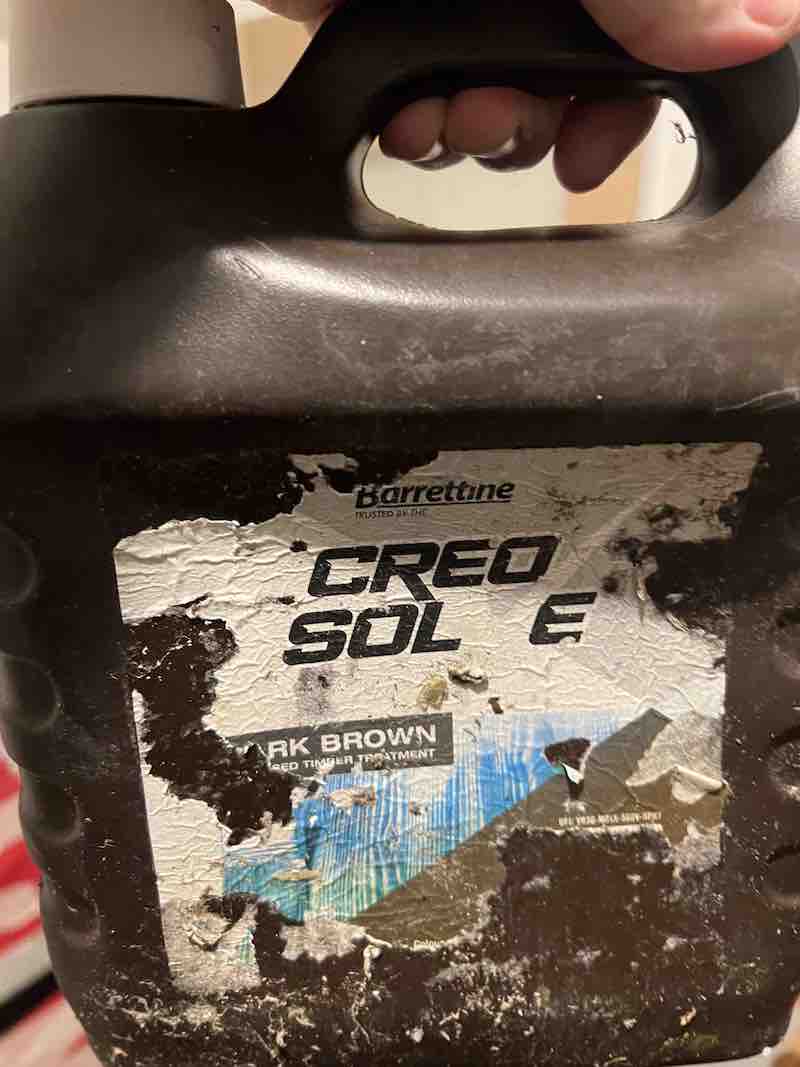
The reason being is I started the shed with a huge can of creosote because I didn’t think this would make it all the way round the shed, as you can see it’s only a dinky container. Basically it’s going to boil down to a case of availability really. I’ll test this on the fence panels for you vs the Creocote so probably worth taking a look over there at the difference seeing as. I have enough to cover a fence panel easily.
There’s not much more to say without rehashing the same conversation we’ve just had with creocote – maybe take a look at the lighter colour as well – that’s about it. Definitely a decent alternative though.
7. Ronseal RSLSFLB5L 5 Litre Shed and Fence Preserver - Light Brown
Ronseal is known for their amazing wood protecting products and preserves and the Ronseal RSLSFLB5L 5 Litre Shed and Fence Preserver – Light Brown is definitely one of the best products – but in my mind like the Cuprinol stain it’s just too similar to the Creocote to note as a bargain. Don’t take this the wrong way, their combination of long lasting appearance on the wood and woodworm treatment combined, ensures it’s a quality buy rating. This is specifically formulated to provide the sheds with not just colour but the protection as well.
In terms of colour – it’s definitely a deeper stain that’s much less shiny than Creoseal or Creocote – if you’re looking for a dark wood colour / stain on your shed then this might well be what you’re looking for…
It goes without saying – this is pretty nasty stuff like Creocote too. So when you apply it has all the same warnings I’ve already gone through. You’ll either spray on or brush two coats – give it a few hours between and you’ll be good to go. There’s really not too much to add as I’ve covered it all above on the previous reviews.
- Apply 2 coats of the formula for better protection
- Water repellent and waterproof formula
- Prevents further decaying of the wood
8. Cuprinol 5L Shed and Fence Protector Chestnut
Yet another one of the good quality shed and fence paints definitely has to be the Cuprinol 5L Shed and Fence Protector Chestnut. The bottom line is this is pretty similar to creocote and whilst I am a huge fan of Cuprinol, I would definitely be picking Creocote or Creoseal ahead of this just down to sheer value for money. Don’t get me wrong, the results are excellent – but why pay more? You only have to look online to see how people are taking this product – I wonder if they knew they can get a similar result for much less money would they be so happy? 😀
However, I will say one thing, this sits much better on smooth timber than Creocote – so that is probably the only time I would pick this mind. It does penetrate deep into the wood and helps ensure that it won’t promote any further decay, which is something that you don’t necessarily get with the other products that have a paint pigment. You have to look to the oil based / solvent sealers for this quality.
- Penetrates deep into the wood to get rid of decay and possible infestation of insects
- Waterproofs the wood
- Adds in a natural finish and protection to the wood
- Dries down pretty quickly after application
Final thoughts
Shed and fences are almost mandatory in every house, right? While we delve out interest and care into taking care of our garden furniture and the other wood necessities in our house, there are often times that we fail to pay attention to the shed and fence. What this does is end up affecting them because of negligence and we end up repenting the same for good. If you have been looking around for good quality shed and fence stain for yourself, we do have an extensive range of products that we would like to share on here.
In this, we have sorted out the best products that we feel would be the best option to look into if you want to keep your shed and fence last longer.
If you have been on the lookout for ways to keep your shed and fence in the best possible condition for an extended period of time, these are some of the best protectors that you can get in the market and that too, for the best available price altogether.









Hi Terry
Thanks for your brilliant content and detailed reviews which has helped me a lot.
Quick question regarding Creocote – I intend to cover 100sqm of fencing using this with the Wagner Fence and decking sprayer – would this be a combination you would recommend ?
Morning Dean,
Yes though Creocote is so thin, the cheapest sprayer will do (I use a hand pump garden sprayer often), you don’t necessarily need the Wagner. However, as a paint sprayer to tuck away in the shed the Wagner been really good to me. Benches, Table tops etc.
Regards
Terry